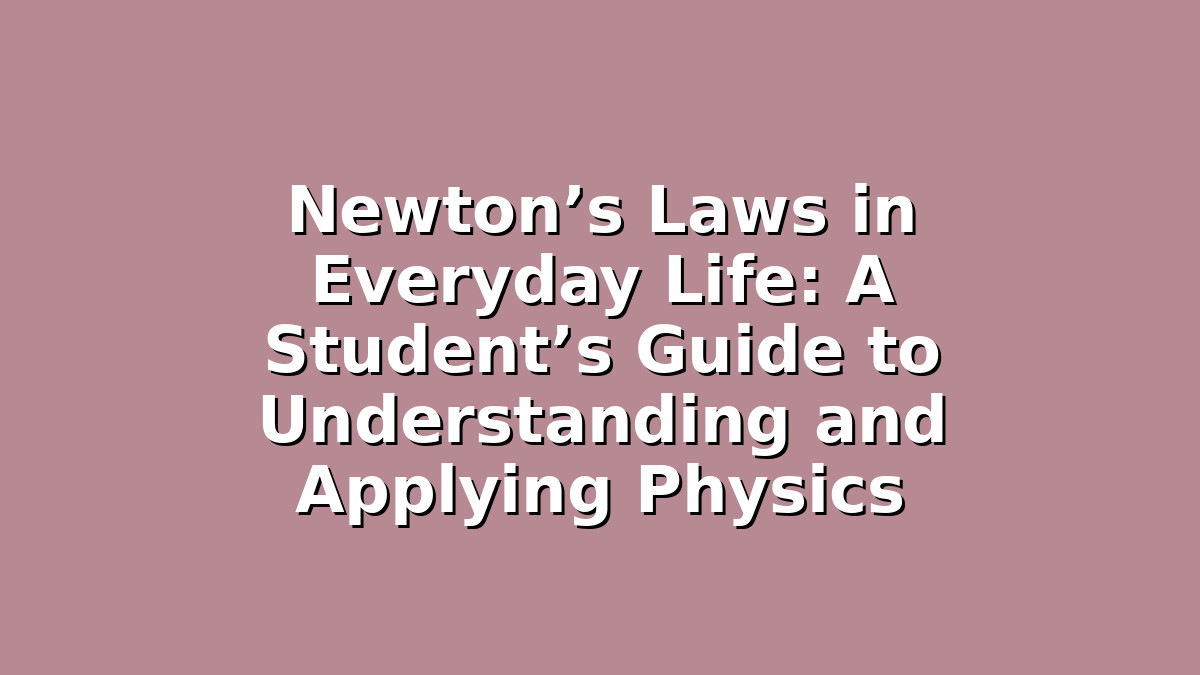Introduction
If you’re a student preparing for exams or simply interested in how science connects to the world around you, understanding Newton’s Laws of Motion is a great step forward. These three fundamental laws, formulated by Sir Isaac Newton in the 17th century, describe how objects move and interact with forces. While they might seem like abstract concepts in textbooks, Newton’s Laws are everywhere in our daily lives — from walking to playing sports, and even when you’re sitting at your desk studying. Grasping these laws not only helps you score better in physics exams but also deepens your appreciation of the physical world.
In this article, we’ll explore each of Newton’s Laws with relatable examples and offer practical study tips to help you master the concepts efficiently. Whether you’re cramming for exams or building a solid foundation for future science courses, these insights will boost your confidence and understanding.
—
Section 1: Newton’s First Law – The Law of Inertia and Study Motivation
Newton’s First Law states that an object at rest stays at rest, and an object in motion stays in motion at a constant velocity unless acted upon by an external force. In simple terms, things don’t change their state unless something pushes or pulls them.
Everyday Example: Imagine your books lying on your desk. They won’t move unless you pick them up or push them. Similarly, when you’re sitting and studying, your motivation can be seen as an “object at rest.” Without an external force, such as a goal or encouragement, it might stay that way.
Study Tip: Use the Law of Inertia to your advantage by creating small “forces” to get started with your study sessions. For example, setting a timer for just 5 minutes can act as the push you need to begin reading or solving problems. Once you start, momentum builds, and you’re more likely to keep going. This is sometimes called the “5-minute rule” and can overcome procrastination inertia.
Additional Advice: Set clear, achievable goals before each study session. These goals act as external forces that keep your studying “in motion.” Reward yourself after completing tasks to maintain that momentum.
—
Section 2: Newton’s Second Law – Force, Mass, and Acceleration in Learning
Newton’s Second Law is often written as F = ma, meaning Force equals mass times acceleration. In physics, it explains how an object’s acceleration depends on the force applied and its mass.
Everyday Example: Think of pushing a shopping cart. An empty cart requires less force to accelerate than a full one. The heavier the cart, the more force you need to get it moving quickly.
Applying to Study: Consider your brain as the “mass” and your study effort as the “force.” If you want to accelerate your learning (improve rapidly), you need to apply enough “force” through effective study techniques and focused effort.
Study Tip: Increase your “force” by using active learning strategies — such as summarizing notes, quizzing yourself, or teaching concepts to classmates. Passive reading might feel like a light push on a heavy cart: slow and inefficient. Active engagement is like pushing hard on an empty cart, accelerating your understanding faster.
Additional Advice: Break down complex topics into smaller, manageable chunks to reduce “mass.” This makes it easier to accelerate your learning without feeling overwhelmed. For example, instead of trying to memorize an entire chapter, focus on key concepts one at a time.
—
Section 3: Newton’s Third Law – Action and Reaction in Group Study and Exam Preparation
Newton’s Third Law states that for every action, there is an equal and opposite reaction. This law emphasizes interactions and mutual influence.
Everyday Example: When you jump off a boat onto a dock, you push the boat backward as you move forward.
Applying to Study: When preparing for exams, your efforts don’t just affect you; they can influence your environment and peers. Studying in groups is a great example of action and reaction — your questions might spark ideas in others, and their feedback helps you improve.
Study Tip: Engage in group study sessions where you actively participate and challenge each other. This interaction acts like forces pushing and pulling, helping everyone gain better understanding. The “reaction” you receive — clarifications, explanations, and motivation — makes your study more effective.
Additional Advice: Balance your “action” by also listening carefully and being open to feedback. The more you contribute, the more you receive in return, creating a positive cycle of learning.
—
Conclusion
Newton’s Laws of Motion may have been formulated centuries ago, but they offer powerful insights not only into physics but also into how we approach daily tasks, including studying. By connecting these laws to your study habits and exam preparation, you can make learning more intuitive and enjoyable.
Remember:
– Use Newton’s First Law to overcome procrastination and build study momentum.
– Apply Newton’s Second Law by increasing your study “force” with active learning techniques and breaking down material.
– Benefit from Newton’s Third Law by engaging in interactive group study and embracing feedback.
With these perspectives, physics becomes less intimidating, and your study sessions become more productive. Keep pushing forward, and just like Newton’s Laws explain movement in the universe, they can help move your academic progress in the right direction!

Responses